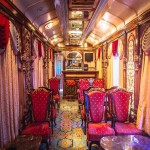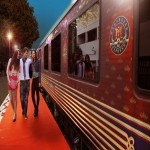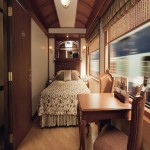Itinerary -
DAY 1 - Delhi - Agra
2045 Welcome & Check-in formalities at Delhi Safdurjung Railway Station
2130 Dinner on board
2200 The Maharajas' Express leaves for Jaipur
DAY 2 - Agra
0630 Arrive into Agra. Proceed to visit the Taj Mahal
0900 Champagne breakfast at Taj Khema
1030 Return to the Maharajas' Express OR you may choose optional activities such as Spa at five star hotel OR Visit to Itmad-ud-daula
DAY 3 - Ranthambore - Jaipur
0630 Proceed for an exciting Game Drive at Ranthambore National Park
0930 Breakfast at Vivanta By Taj, Sawai Madhopur
1045 Return to the comfort of the Maharajas' Express
1100 The Maharajas' Express proceeds for Jaipur.
1400 Visit the Amber Fort OR You may also choose to participate in the optional activities such as Spa facilities at a 5 star hotel OR Private shopping tour OR Golfing at Rambagh Golf club OR Visit to City Palace & Jantar Mantar (The Observatory)
DAY 4 - Bikaner
0800 Enjoy countryside while having breakfast on board
1000 Arrive into Bikaner. Relax on board OR You may also choose optional activities such as visit to the Lallgarh Museum OR Deshnok (the Rat Temple) OR a Private shopping tour for Kundan Jewellery.
DAY 5 - Jodhpur
0800 Breakfast on board
0900 Optional tour to Bishnoi village OR enjoy Spa facilities at a 5 star hotel.
DAY 6 - Udaipur
0800 Breakfast on board
1000 Arrive into Udaipur
1030 Proceed for sightseeing of City Palace & Crystal Gallery (Audio Tour)
1330 Lunch at Satkar Hall of Fateh Prakash Palace
1430 Return to the train for a relaxed afternoon OR continue for a shopping tour. You may also opt for the optional service like Spa facilities at a 5 star hotel or visit to Vintage Car Museum & Boat Cruise on Lake Pichola.
DAY 7 - Balasinor
0630 Breakfast on board
0730 Arrive into Sevalia Station
0745 Drive to Balasinor.
0830 Depart for Dinosaur Fossil Park
0930 Arrive at Dinosaur Fossil Park for a guided tour by Princess Aaliya followed by Village Walking Tour.
1145 Lunch and unique cultural performance at Babis' Residence, Balasinor
1400 Return to the comfort of Maharajas' Express.
1630 Train leaves for Mumbai
2000 Enjoy an "Indian Evening" followed by dinner.
DAY 8 - Mumbai
0700 Breakfast on board
0815 Train arrives at Mumbai Lokmanya Tilak Terminus
0830 Disembark and bid farewell to the Maharajas' Express as your journey comes to an end!
Trip Ends With Sweet Memories !!!
AGRA
1.The Taj Mahal :
Taj Mahal was built by a grief stricken Emperor Shahjahan as a memorial to his beloved wife Mumtaz Mahal. A world-renowned wonder, Taj Mahal sits pretty on the northern side of this green paradise. It looks the same from all the four sides! The Quranic inscriptions on its four entrances are carved in such subtle increase in size that may appear to be of the same size from top to bottom! Shahjahan invited master craftsmen from as far as Italy and Persia to help design his ambitious tribute to love.
The Taj Mahal is phenomenal not in the beauty alone that shines forth, but in the deep planning and design that went into its making, and the ethereal idea of immortalizing love. Delicate carvings in marble vie with gorgeous pietra dura for attention. Lapis-lazuli, Cornelian, Mother of pearl, Agate and Emerald are inlayed in floral and geometrical patterns in the marble itself. This enchanting mausoleum, on the bank of river Yamuna started in 1631 and it took 22 years to complete with the help of an estimated 20000 workers.
RANTHAMBORE
1 .Ranthambore National Park :
It was once the private hunting grounds of the Kings and Royals of Jaipur. Spread over 392 sq km, the park has steep crags embracing a network of lakes and rivers. The terrain is a blend of impregnable forests and open grasslands. The forest is open deciduous type with Dhok being the most prominent tree. The park can be visited in the morning and evening either by canter or gypsy.
At Ranthambore, tigers are readily observed during daylight, hunting or lazing around, oblivious of jeep load of tourists and their cameras. Apart from tigers, the park has a wide variety of animals, birds and reptiles. One can find Marsh Crocodiles, Hyenas, Leopards, Jungle Cats, Fox and Jackal apart from Chital, Nilgai and Chinkara. Sambhar Deers are the pride of Ranthambore.
The park has more than 300 varieties of avian population including Black Storks, Quails, Crested Serpent Eagles and Painted Storks.
JAIPUR
1. Amber Palace :
Amber (pronounced Amer) is situated about 11 kilometres from Jaipur and was the ancient citadel of the ruling Kachwahas of Amber, before the capital was shifted to the plains, the present day Jaipur.
The Amber Fort set in picturesque and rugged hills is a fascinating blend of Hindu and Mughal architecture. Constructed by Raja Man Singh I in 1592 and completed by Mirja Raja Jai Singh the fort was made in red sand stone and white marble. The rugged forbidding exterior belies an inner paradise with a beautiful fusion of art and architecture. Amber is the classic and romantic fort-palace with a magnificent aura. The interior wall of the palace depicts expressive painting scenes with carvings, precious stones and mirror settings. In the foreground is the Maota Lake providing a breathtaking vista. Built mainly for the warring enemies as a safe place, the heavily structured walls could defend the residents within the ramparts of the fort.
All means of survival and luxuries for the royal families and the people who were concerned with the functioning of this small kingdom of the Kachhawas were well provided. The Rajputs who had apparently won a small structure passed on by Meena tribes, later on renovated it into the grand Amber Fort. Holding a history as old as seven centuries, this place vibrates with its legendary past. Although many of the early structures have been literally ruined but at the same time, those dating from 16th century onwards are remarkably well preserved by sincere efforts.
2.City Palace :
Located in the heart of the walled city, the City Palace Complex gives you an idea about the farsightedness of the founder of Jaipur Maharaja Sawai Jai Singh. He left behind a legacy of some of the most imposing and magnificent architecture in the city. Maharaja Sawai Jai Singh built many buildings but some of the structures were also built by later rulers. The palace is a blend of Mughal and Rajput architecture and the ex-royal family still lives in a part of the palace.
On entering the complex and before the proper palace lies the Mubarak Mahal, the palace of welcome or reception. Maharaja Sawai Madho Singh built the palace in the nineteenth century. It was used as a reception centre for the visiting personage. The building now forms the Maharaja Sawai Man Singh II Museum and on display here are a wide array of royal costumes, some very exquisite and precious Pashmina (Kashmiri) shawls, Benaras silk saris, Sanganeri prints and folk embroidery. An unusual display is that of voluminous clothes worn by Maharaja Sawai Madho Singh I (ruled 1750-68).
The Maharani's Palace, the palace of the Queen paradoxically puts on a display of the Rajput weaponry. The inestimable collections of weapons date back to even 15th century and are in a remarkable state of preservation. Remarkable amongst them is scissor-action dagger. This deadly weapon were so designed that the handles were released to spread the blades when thrust into bodies. The dagger was then withdrawn fatally tearing limb to limb of the body of the hapless victim. Other exhibits include protective chain armours, pistols, jewelled and ivory handled swords, a belt sword, small and assorted cannons, guns, poison tipped blades and gun powder pouches. The frescoes on the ceiling are amazing and well preserved.
The art gallery is located in the Diwan-I-Aam, which literally means the hall of public audience. The exhibits here include some very precious and ancient handwritten original manuscripts of Hindu scriptures. Particularly intriguing are miniature copies of Bhagwat Gita made in such a manner that it could be protected from Emperor Aurangzeb's onslaught on Hindu scriptures. Some delicate miniature paintings pertaining to Rajasthani, Mughal and Persian schools on various themes including the Ramayana are engrossing displays. Visitors must take a good look at the preserved painted ceilings. Also on display are elephant saddles called "haudha".
Between the armoury museum and the art gallery is the Diwan-E-Khas meaning hall of private or selective audience. This is a marble paved pavilion and puts on display the world's largest sterling silver objects, two gigantic silver vessels. These vessels were made for Maharaja Sawai Madho Singh II, who filled these vessels with holy Ganga water and took them along with him during his journey abroad. The idea was to drink exclusively the water from the river Ganga. The Guinness Book of Records declared the silver vessels as the biggest silver objects in the world. The ceiling also has large chandeliers, which are mostly protected by dust covers and opened only for festive occasions.
The Chandra Mahal Palace is still occupied by the ex-royal family but visitors can visit the ground floor where some exhibits are on display. A visit here is worthwhile for the exquisite Peacock gate in the courtyard outside.
The present day royal family that takes charge of the museum has done exceptionally well in preserving and maintaining this legacy for presentation to visitors. A visit to the palace is both interesting and enlightening.
BIKANER
1. Gajner
Gajner is an incomparable jewel in the Thar. It was built by the great Maharaja Ganga Singh of Bikaner on the embankment of a lake with a generous dose of flora and fauna. Basically a hunting and relaxing lodge, the maharaja and the family shared their passion with their exclusive guests and hosted exotic holidays for them. Around the palace is a thick forestation that encourages the guests to go for a simple walk admiring the migratory birds in winter like imperial sand grouse, antelopes, black bucks and the animal species that wander around in the form of Nilgais, chinkaras, deers etc. The hotel is spread over a large area, and the ambience around is as raw and authentic as it was before.
2. Junagarh
It is an unassailable fortress, which had never been conquered. Built in 1593 A.D. by Raja Rai Singh, one of the most distinguished generals in the army of Emperor Akbar, the fort is a formidable structure encircled by a moat.
The main entrance to the fort is Karan Pol [gate] that is facing east. Next to it is the Suraj Pol meaning the sun gate. In the fort complex are some magnificent palaces like Anup Mahal, Ganga Niwas and Rang Mahal or palace of pleasure. The Har Mandir is the majestic chapel for the royal family for worshipping their gods and goddesses. These palaces, constructed in red sandstone and marble, make a picturesque ensemble of courtyards, balconies, kiosks and windows dotted all over the structure. The premises also house a museum, which has an array of rich collection.
JODHPUR
1. Mehrangarh Fort :
Perched on a 150 m high hill its sprawl is the most formidable and magnificent fort in Rajasthan. Rao Jodha founded it in 1459 but subsequent rulers of Jodhpur have also added to it over the centuries. A meandering road leads to the from the city 5 kms below. Battle scars of canon ball hit by attacking armies of Jaipur can still be seen on the second gate. To the left is chhatri of Kirat Singh Soda, a soldier who fell on the spot while defending the fort against the armies of Amber. There are seven gates, which include Jayapol meaning victory built by Maharaja Man Singh to commemorate his victories over Jaipur and Bikaner armies.
Fatehpol also meaning victory gate was built by Maharaja Ajit Singh to mark the defeat of Mughals. The palm imprints still attract devotional attention and are covered by vermilion paste and paper-thin silver foil.
2. Clock Tower Market :
The Clock Tower is a popular landmark in the old city. The vibrant Sadar Market is close to the tower and narrow alleys lead from here to bazaars selling Spice, Indian sweets, textiles, silver and handicrafts. It's a great place to ramble around at leisure.
Udaipur
1.City Palace
City Palace towers over the Pichola Lake. Maharana Udai Singh initiated the construction of the palace but successive Maharanas added several palaces and structures to the complex but retained remarkable uniformity in the design. The entry to the Palace is from the Hati Pol, the Elephant Gate. The Bari Pol or the Big Gate brings you to the Tripolia, the Triple gate. It was a custom to weigh the Maharaja under this gate in gold and silver, which was distributed to the populace. It is also now the main ticket office. Balconies, cupolas and towers of the palace give a wonderful view of the lake. Suraj Gokhada (or the balcony of the sun) is where the Maharana would grant public audiences mainly to boost the morale of the people in trying times. The Mor Chowk is the Hindi name of peacock square and is named after a vivid blue decorative glass peacock on the wall.
The main part of the palace is now preserved as a museum displaying a large and diverse array of artifacts. As we go down the steps from the entrance is the armoury museum exhibiting a huge collection of protective gears and various kinds of weapons including the lethal two-pronged sword. The City Palace museum is then entered through the Ganesh Deori. This leads to the Rajya Angan or the royal courtyard. This is the spot where Maharana Udai Singh is said to have met the sage who advised him to found a city here. The rooms of the palace are superbly decorated with mirror tiles and paintings. Manak Mahal or the Ruby Palace has a lovely collection of glass and mirror work while Krishna Vilas displays a rich collection of miniature paintings. Moti Mahal (the pearl palace) has beautiful mirror work and the Chini Mahal has ornamental tiles all over. The Surya Chopar (the sun square) depicts a huge ornamental sun symbolising the sun dynasty to which the Maharajas and their ancestors belonged. The Bari Mahal is a central garden giving a view of the city. Some more beautiful paintings can be seen in the 'Zenana Mahal' (the ladies chamber). Then, there is the Lakshmi Chowk which is a beautiful white pavilion.
2.Crystal Gallery
Situated in the Fateh Prakash Palace, it has a breath taking collection of crystals. These were ordered by Maharana Sajjan Singh from F & C Osler England but could not live to see them because of his untimely death. The crystal items include tables, sofa sets, dining tables, dressers, fountains and even beds besides a whole array of washing bowls, decanters and perfume bottles. There is also an exquisite jewel studded carpet.
3.Fateh Prakash Palace
The Fateh Prakash Palace, the grand heritage palace hotel of the HRH group represents the authentic royal luxury at its best. The warmth of royal hospitality greets you as you walk along the corridors lined with large paintings of the Mewar School that flourished through the seventeenth to the nineteenth century.
The lake facing suites in the turrets are suitably appointed with four poster beds and period furniture, festooned with maroon velvet curtains and delicate silk tassels. It's a legacy kept alive since the early decades of the twentieth century when Maharana Fateh Singh (period of reign: 1884 - 1935) used to be the royal occupant of this palace. Till date the formality of royal occasions are maintained.
About The Tour:
A Panoramic view of Treasures, Heritage and Splendour of India, the Maharajas Express is one of the most lavish trains that operates in five different journeys. The train has been awarded as the leading luxury train of India, at 2012 World Tourism Award function. The Maharaja Express luxury train covers North-Western India, mainly glorious forts and palaces of Rajasthan with champagne breakfast along with the Taj Mahal and Exhibition Elephant polo match. Operating from October to April, the journey has been often compared to the Orient Express of Europe.
By Maharaja Express Booking, one can avail the facilities and services offered that are luxurious to the extent of being pampered. From 'Namoh', you can book a luxury train ride in Maharaja Express and live a life that is akin to the emperors, which is not something you get in your day-to-day routine.
A wonderful journey through a magical land.
In this journey visit the world's greatest monument of love the Taj Mahal, spot the elusive tiger in Ranthambore National Park, soak up the spectacular regal heritage of Rajasthan in its magnificent forts, vibrant Bazars and the Royal cuisine. The journey will leave you with everlasting memories of a unique mix of Culture, History and Folklore.










